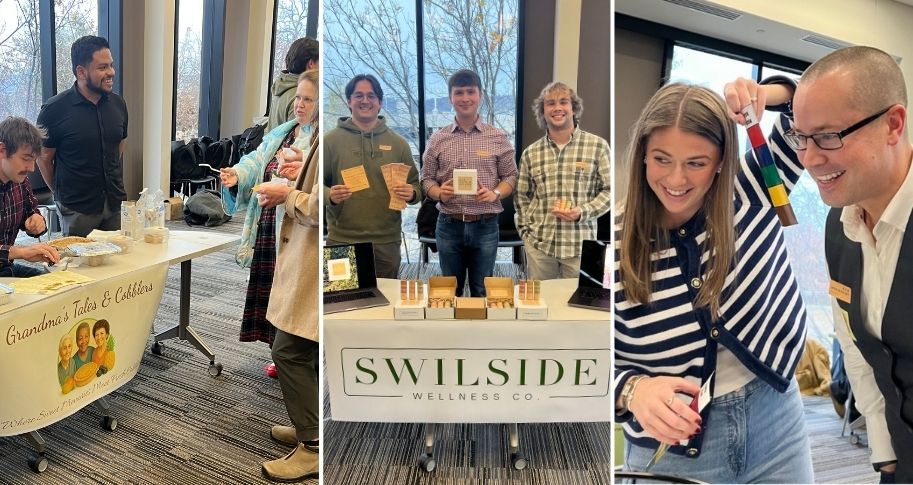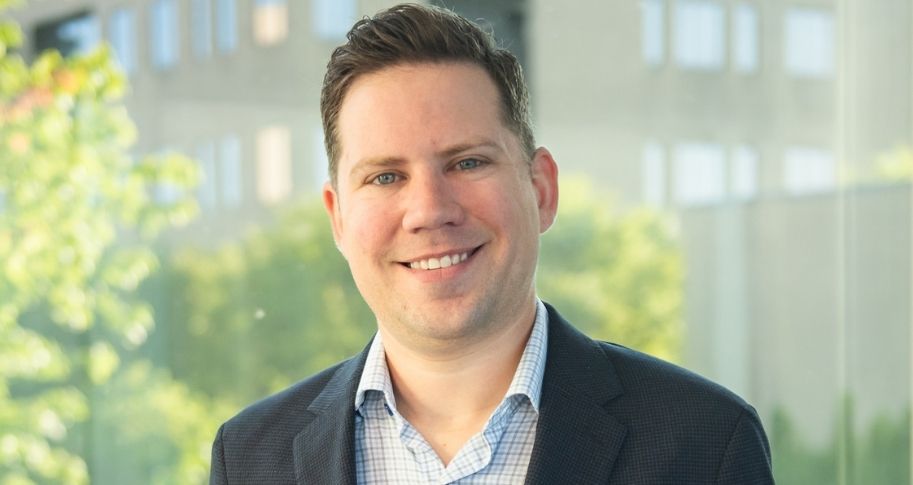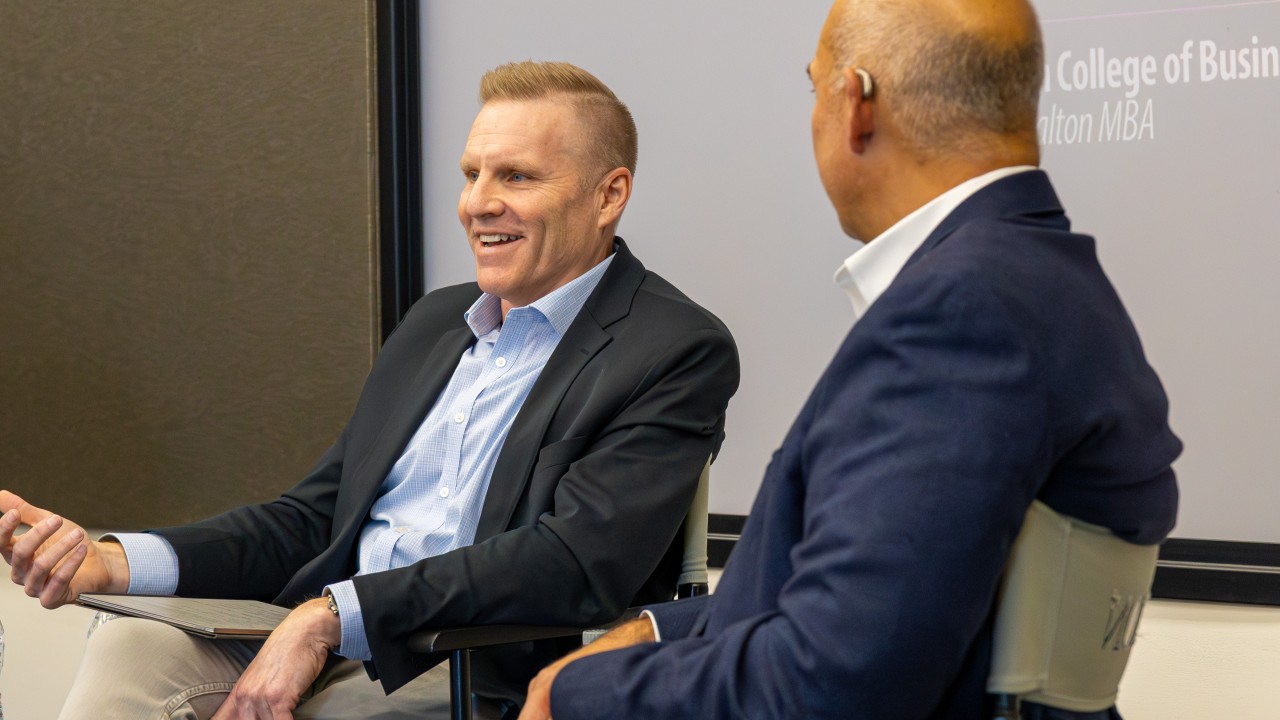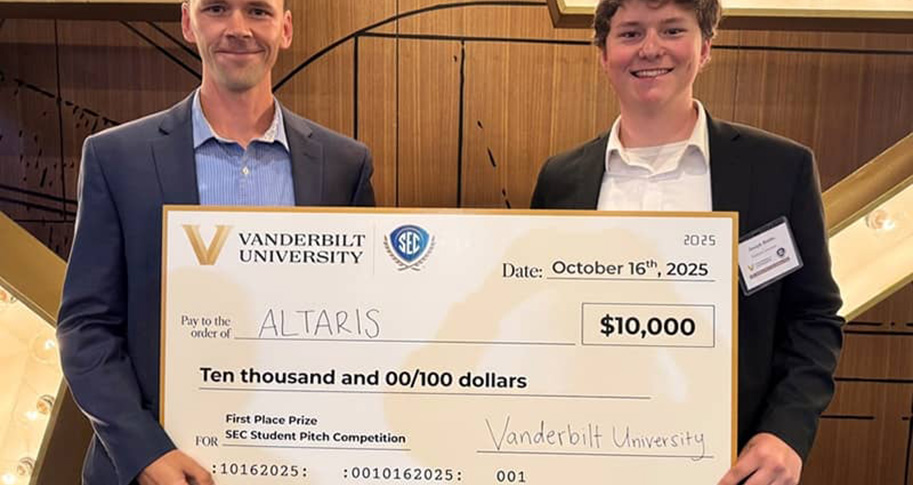Christy Melhart Slay, director of technical alignment for The Sustainability Consortium, a global organization co-led by the University of Arkansas and Arizona State University that helps industries “define, develop and deliver more sustainable products,” earned her Ph.D. in biological sciences from the University of Arkansas in 2010. As a graduate student she was interested in sustainability and the intersection of science and business.
Slay reached out to Jon Johnson, professor in the Walton College and the Department of Strategy, Entrepreneurship and Venture Innovation at the University of Arkansas and founder and chair of the board at The Sustainability Consortium, and asked about opportunities in the Applied Sustainability Center, which would later become The Sustainability Consortium. Slay helped Johnson in the early phases of development of The Sustainability Consortium and says her job today allows her to see real-world impacts for initiatives close to her heart. Slay says she loves translating science for businesses, and now for Walton College students, too, as a graduate professor in the Walton College.
Slay shared answers to a number of questions on resiliency and sustainability in the wake of COVID-19.
How is resiliency related to sustainability?
Slay says resiliency planning and sustainability are closely related, even if they are not often taught together. Long-term strategic thinking and building stable, quality, shock-resistant supply chains are vital to resiliency planning and sustainability initiatives.
To make sustainable purchases you must understand the social and environmental impacts of those purchases. Knowing where and how suppliers are sourcing and producing products helps sustainability and resiliency planning. Effective and efficient bridging and buffering strategies can only be developed if there is a solid foundation of knowledge of sourcing and production to build on.
Bridging strategies involve, “building collaborations with your supply chains to know who they are, how they operate, where they are and what they are doing.” Buffering strategies require “being able to shift, pivot and buffer yourself from a supplier who might not be able to deliver.” Both strategies are important contingency plans for supply chain resiliency and involve strategic, long-term planning with social and environmental impacts in mind, much like sustainability.
Slay says it is more than supply and demand in sustainability and resiliency. “It is having those relationships and strategies in place, but also being able to incorporate the environmental and social impacts to make better decisions and encourage suppliers to make better decisions.” Conversations that take into account these relationships and strategies enable businesses to improve their supply chains through mindful and strategic procurement processes.
How have resiliency planning and sustainability initiatives been impacted by COVID-19?
Slay says the current pandemic has “brought to light a lot of gaps in resiliency” but has identified successful resiliency planning and strategies that companies have in place. Slay says “companies will either survive, thrive, learn and prosper in the future from an event like this or, worst-case scenario, go out of business.” Companies that have “solid sustainability programs,” the businesses that are thinking long-term, utilizing bridging and buffering strategies and understand their supply chains, are often the companies that do well in times of uncertainty, Slay says.
Slay says most companies plan for a single supply chain disruption like more common natural disasters, such as tornadoes or floods. These events are short term, in one place and often short-lived. COVID-19 is a global pandemic with widespread, long-term and unprecedented effects on natural, economic, physical and social systems (Slay 2020). Slay does not think any company has really planned for the extent to which COVID-19 has caused such extensive disruptions to daily life around the world, but companies that were thinking “more strategically, in the resilient, long-term framework” will be the companies that survive.
Which sustainability initiatives are suffering?
Slay says there has been an important shift to human health and human health impact initiatives in the wake of COVID-19. Environmental initiatives are simply “not getting attention right now.” Single-use plastic initiatives, which Slay says were “really picking up steam” pre-pandemic, have “gone by the wayside for the purposes of human health.” On the governmental level, Slay says, different governments “are loosening environmental regulations to get businesses back up and running,” as seen in China. In Brazil, the Amazon forest is not being monitored, and illegal logging is underway, and indigenous people are under threat.
There have been huge disruptions to food supply chains due to COVID-19. People are not going to restaurants, more people are eating at home, and as a result, diets are changing. Entire fields of food crops are being plowed under due to lack of demand from restaurants, hotels and universities. Farmers and restaurants have lost billions in revenue, while food banks and food waste programs are “struggling to get food to the people who suddenly need it.” At the same time, notes Slay, unemployment has skyrocketed, and more people need these services.
What sustainability initiatives are thriving?
With the new focus on human health, Slay says there has been “incredible momentum” and “demand for the science” to try to find a vaccine for COVID-19. She hopes the connections between human health and the environment, important aspects of sustainability, will become more obvious as we learn about COVID-19.
Supply chain sustainability initiatives like The Sustainability Consortium are still thriving in the wake of COVID-19. Companies understand the importance of sustainable, resilient supply with measurement and reporting identifying important opportunities for improvement. Slay hopes there will be positive impacts on human health and human health impact planning as a result of the pandemic. The environment, wildlife and human health are very closely connected. Slay hopes that connection will become more evident, saying “They are complicated connections, but with this particular virus, those connections are very clear.”
Are you concerned about future funding for sustainability initiatives and organizations?
Slay says sustainability is thriving right now and she is grateful to all The Sustainability Consortium members who have weathered the changing landscape of sustainability together since 2009. She is especially proud to work with those members who have doubled-down on sustainability in the wake of COVID-19. Slay says for the moment, The Sustainability Consortium is continued to execute their 5-year strategy announced earlier this year. In the interim, Slay and the TSC team have worked to deliver virtual, remote content and reassures members that work continues to be done. As she says, “Even though lives are disrupted, sustainability is still moving forward.”
How is the COVID-19 pandemic shaping sustainability?
Slay says there is still a lot of work to be done to connect the COVID-19 out break with sustainability. For those immersed in sustainability “the connections are clear,” but for many those connections still need to be made. Slay says it is her job, and the job of sustainability professionals, “to make those connections clear.” Slay says “whole systems are complicated, but in this case the connections are clear… if you slow down and just think about them.”
Paper products, for example, says Slay, are a great example. What happens when we run out? Where did that paper come from? Where will replacements come from? Are environmental regulations being relaxed to accommodate the sudden spike in demand? Slay says these are important questions to ask about sourcing and supply chains that relate to sustainability and resiliency planning:
“When forests are harvested for paper products it releases carbon and removes the carbon storage that forest provides which creates greenhouse gas emissions which cause climate change. You need to know where your supply chains are. The location of the forest and type of forest determines the amount of impact. Companies need to realize where they are reaching and consumers need to understand the impacts of purchases and their purchasing power.”
A similar approach is being used to understand COVID-19: Where did it come from? How did it come to be? What are the impacts on individuals, organizations and other systems? How are companies, businesses and individuals responding? Communicating the science to consumers and corporations can help create whole system connections which are vital to sustainable practices and building resilient supply chains.
How can sustainability- and resiliency-focused whole system models help prepare for national (and global) emergencies?
Slay taught a graduate sustainability course in the Walton College this past semester. She says the class talked “a lot about how things are made, what the impacts are and what we can do about it.” She says the same approach is important for developing sustainability – and resiliency-focused systems that are better able to withstand major disruptions.
Slay says sustainability- and resiliency-focused whole system modeling requires “looking at the entire system and closing the loop.” There are several ways to be creative when connecting outputs and inputs from different supply chains and between industries, such as using waste from one supply chain as an input for another supply chain and trying to be more efficient in manufacturing.
Even though COVID-19 is unprecedented, Slay believes other, similar event may occur in our lifetime. Planning for events we know are going to happen regularly, such as natural disasters, and developing supply chains that are focused on circular economics and renewable materials (“green” supply chains), will help whole systems be better prepared in the future to withstand both short-term shocks and long-term disruptions.
Creative solutions come through innovation and constant communication. Slay hopes some of the economic incentives and financial assistance being provided right now will be dedicated to innovation and creative solutions for circular economies and cleaner, greener supply chains.
Hopes for the future?
Slay hopes we will all realize through COVID-19 that having a healthy planet translated to healthy people, “The things that are valuable are time with our families, our health, taking long walks and enjoying nature.” She hopes people “don’t rush back to their busy lives” and hopes consumers become more conscious about what they buy, how much they buy and how they buy it to protect people and the planet for future generations.





